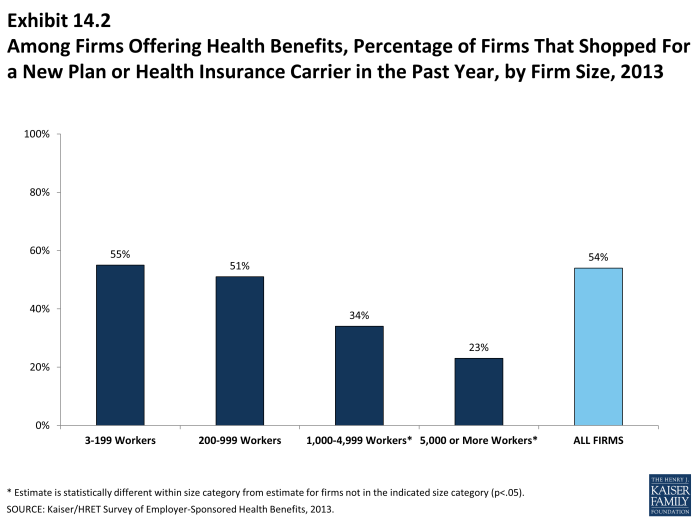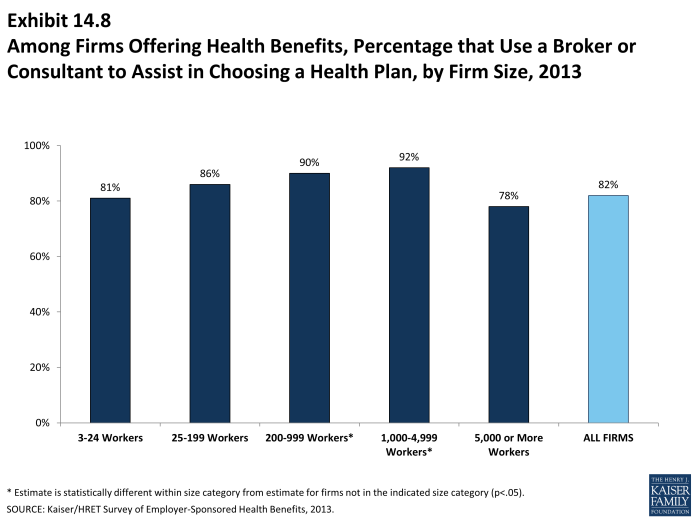2013 Employer Health Benefits Survey
Section Fourteen: Employer Opinions and Health Plan Practices
Employers play a significant role in health insurance coverage – so their opinions and experiences are important factors in health policy discussions.
Employer Opinions on Cost Containment
Firms offering health benefits were asked to rate how effective several different strategies, such as wellness programs, tighter managed care restrictions, consumer-driven health plans, higher employee cost sharing, and disease management programs, would be in reducing the growth of health insurance costs.
- Thirty-five percent of firms offering health benefits stated that wellness programs would be very effective at containing health insurance costs, more than any of the other strategies. There was no statistical difference in the distribution of opinions between small (3 to 199 workers) and larger firms towards the effectiveness of wellness programs (Exhibit 14.1).
- Eight percent of firms offering health benefits stated that tighter managed care restrictions would be “very effective” at containing health insurance costs, fewer than any of the other strategies (Exhibit 14.1). Larger firms were more likely than smaller firms to state that tighter managed care restrictions were “very effective”.
Shopping for Health Coverage
More than one-half (54%) of firms offering health benefits reported shopping for a new health plan or a new insurance carrier in the past year, suggesting that the market is quite dynamic (Exhibit 14.2). Among firms that offer health benefits and shopped for a new plan or carrier, 18% changed insurance carriers and 15% reported changing the type of health plan provided to employees. A firm is considered to have changed health plan types when they switch between conventional, HMO, PPO, POS or HDHP/SO plans. There were no significant differences between small firms (3 to 199 workers) and larger firms on either these measures (Exhibit 14.3).
The majority of firms offering health benefits use a broker or consultant to assist in choosing a health plan (82%) (Exhibit 14.8). Large firms offering health benefits (200 or more workers) are more likely than smaller firms to use a broker or consultant (90% versus 82%).
Retail Clinics and Nurse Hotlines
Among firms offering health benefits, over half (56%) cover care received at retail clinics in their plan with the largest enrollment. Retail clinics treat minor illness and provide preventive care at locations such as retail stores, pharmacies, and supermarkets. Among these firms covering care at retail clinics, 17% offer financial incentives to receive care at a retail clinic location rather than at a physician’s office. There is no significant difference between small firms (3 to 199 workers) and larger firms covering care received at a retail clinic or for offering financial incentives to do so (Exhibit 14.5).
Among plans with the largest enrollment in firms offering health benefits, over half include a nurse hotline (55%). Large firms offering health benefits (200 or more workers) are more likely than smaller firms to have a nurse hotline (74% vs. 54%) (Exhibit 14.7).
Tiered Networks
A tiered or high performance network is one that groups providers into the network based on quality, cost, and/or the efficiency of the care they deliver. These networks encourage patients to visit more efficient doctors by either restricting networks to efficient providers, or by having different copayments or coinsurance for providers in different tiers in the network.
- Twenty-three percent of firms that offer health benefits include a high performance or tiered provider network in the health plan with the largest enrollment (Exhibit 14.4). This is similar to the 20% reported in 2011 (the last time these questions were asked).
Offering Health Benefits through a Private Exchange
Recently, several large consulting firms have created private exchanges to offer health benefit options for mid-sized and larger employers. While models vary, the general idea is that the exchange contracts with different health plan vendors and offers a number of different health plan options to the employees of participating employers. This permits an employer to offer a larger variety of health plans to employees, and to structure contributions or other rules to encourage employees to choose more efficient plans.
- Nine percent of large firms (200 or more workers) offering health benefits are considering offering benefits through a private exchange. Among offering firms with at least 5,000 workers, 29% are considering offering benefits through the exchange (Exhibit 14.6).








